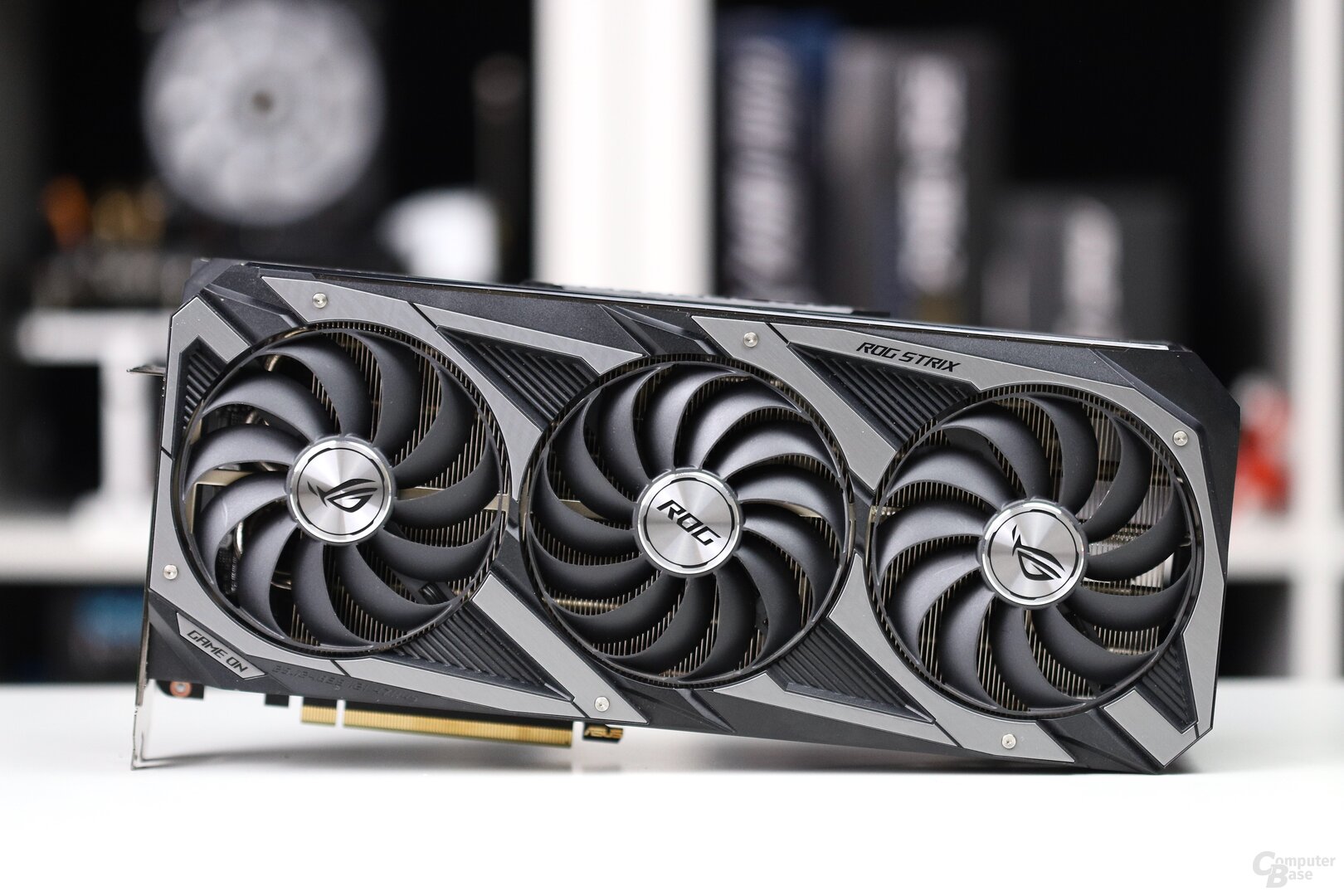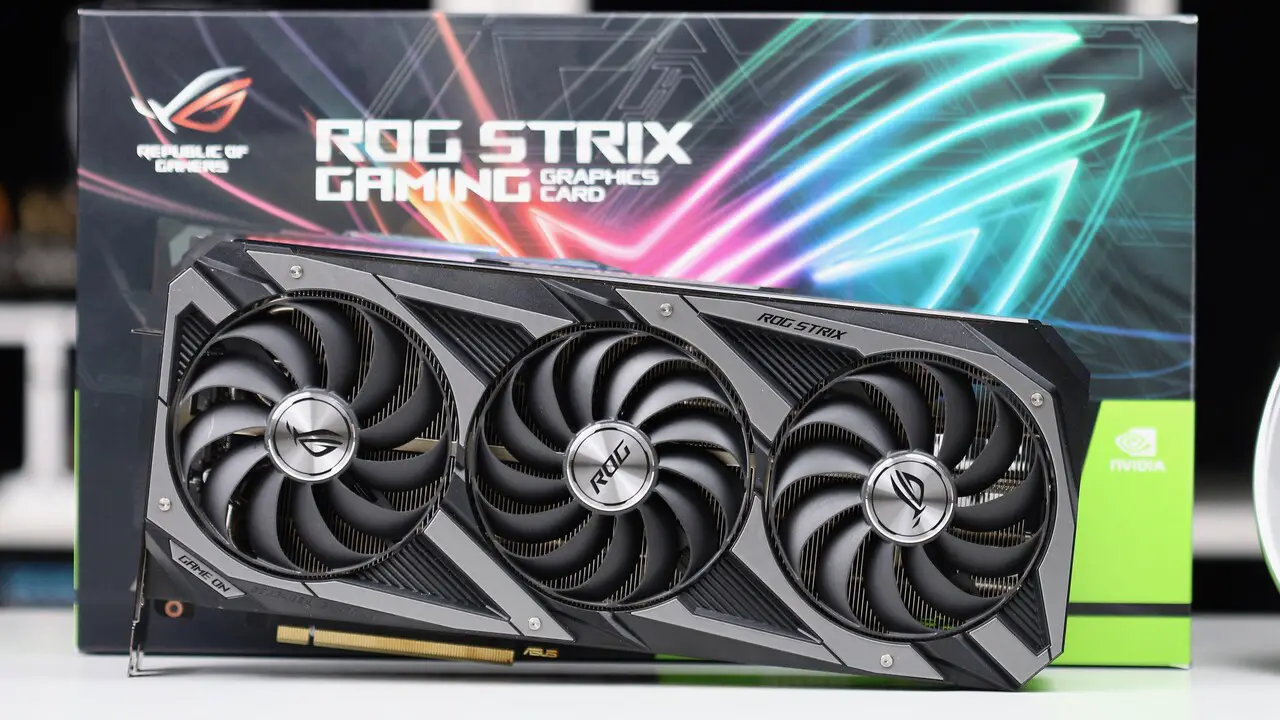Asus ROG GeForce RTX 3090 Strix OC in the test
: Test |CUP | Specs |Config
tl;dr: Asus has not only thoroughly revised the TUF, but also the ROG Strix cooler in the GeForce RTX 3000 series. The test with the Asus ROG GeForce RTX 3090 Strix OC shows: Asus has improved the cooler, but it only sets a new benchmark for RGB lighting.
The Asus ROG GeForce RTX 3090 Strix OC in the test
Asus delivered a real surprise with the GeForce RTX 3080 TUF (test). The TUF series has so far not convinced with quality in the graphics card segment, but the newly developed TUF cooler of the GeForce RTX 3000 series presented itself as quiet and powerful at the same time. The bar for the ROG Strix series is higher than ever. The test of the Asus GeForce RTX 3090 Strix OC flagship, which is officially priced at 1,659 euros, clarifies whether the flagship series still manages to jump over it with the cooler.
With the GeForce RTX 3090 Strix OC, Asus took a few days more time than most other manufacturers to outperform the assembled competition. To achieve this, the Strix comes with a cooler that has been modified again compared to the TUF. In addition, there is a significantly higher maximum power limit and full-blown RGB lighting. The next sections show whether that is enough to beat the strong competition in the form of the MSI GeForce RTX 3090 Gaming X Trio (test).
The sample of the Asus ROG GeForce RTX 3090 Strix OC was sent to the editors on October 2nd, but the factory installed BIOS turned out to be faulty. The 0dB mode does not work correctly. It takes the temperature and also the power consumption into account. In terms of power consumption, however, the threshold was set too low, so that the fans either only stopped for a few seconds or did not stop at all.
After ComputerBase informed Asus of the problem, the manufacturer was able to quickly reproduce it in Taiwan and worked on a new BIOS. With the first update, however, the Quiet BIOS could not be updated, Asus had to improve again. ComputerBase has waited so long.
There is now a correctly functioning BIOS for the GeForce RTX 3090 Strix OC that can be downloaded from Asus itself. Apart from the 0dB mode, there are no changes in the BIOS. The first graphics cards on the market come to customers with the faulty BIOS.
The Asus GeForce RTX 3090 Strix OC in detail
Asus is sending the GeForce RTX 3090 Strix OC into the race with a recommended retail price of 1,659 euros. The catch is that not a single GeForce RTX 3090 is currently available and it is also unclear when this will change. The price information currently has no meaning. Some retailers have taken the graphics card out of the sale right away, others are offering it for pre-order at a higher price. Only Asus itself sells the graphics card in its own new web shop for 1,637 euros, which is less than the RRP. The graphics card can only be ordered there if it is available from stock – and that is currently not the case.
3-slot design with a weight of almost 2 kg
You can see from all corners and edges that Asus wanted to know about the GeForce RTX 3090 Strix OC. It starts with the weight, which at around 1.8 kg shows that the manufacturer has spared no material use. But the graphics card not only looks high-quality due to its weight, the feel is also right.
The 2.9-slot cooler comes with a single aluminum radiator that uses the entire graphics card length of 32 cm. In addition to the GA102 GPU, it also touches the 24 GB GDDR6X memory and the power supply (via pads). There are also seven heat pipes for faster heat transfer. Three axial fans with a diameter of 95 mm provide the necessary fresh air. They are 10 mm larger on the Strix than on the TUF model.
At 26.5 cm, the PCB is slightly shorter than the cooler and fully occupied with components. Asus provides 18 voltage converter circuits for the GeForce RTX 3090 Strix OC for the GPU, the memory has four. The MSI GeForce RTX 3090 Gaming X Trio uses eleven voltage converter circuits for the GPU. Why Asus uses so much more becomes clear when you look at the power limit.
With 480 watts, significantly more energy than the competition
By default, this is set at “only” 390 watts (+40 watts to Nvidia’s reference specifications). Asus allows a maximum of 480 watts. On the other hand, a maximum of only 380 watts is possible on the MSI model. Three 8-pin power plugs are required for operation.

The Asus GeForce RTX 3090 Strix OC in the test
picture 1 from 8
The GeForce RTX 3090 Strix OC comes with two different BIOS versions: the performance BIOS is activated by default, alternatively there is a quiet BIOS. The fan control is the only difference between the software variants and as the test series will show, the Quiet BIOS should definitely be used. This can be activated with a labeled switch on the card.
Asus specifies a base clock of 1,395 MHz for the graphics card, while the average Turbo should be 1,860 MHz. That is 160 MHz more than Nvidia provides for a reference card and the Founders Edition. The 24 GB GDDR6X memory from Micron is controlled at the standard 9.752 MHz.
RGB lighting that is convincing
The GeForce RTX 3000 models previously tested by the editorial team were absolutely economical with RGB lighting, the implementation was rarely convincing. Asus, on the other hand, has worked hard with the GeForce RTX 3090 Strix OC and offers a large, clearly visible RGB bar.
Not only that, because the lighting itself also appears to be of high quality. This can be controlled and also deactivated with Asus’ own tool GPUTweak II. Monitors can be connected to three DisplayPort 1.4 or two HDMI 2.1 outputs.
The clock rates under load
The Asus GeForce RTX 3090 Strix OC clocked at a maximum of 2,070 MHz with low GPU load and low temperatures, but this is not a realistic frequency for gaming. If the power limit does not intervene in the clock, 1980 MHz has proven to be the realistic maximum frequency. Due to the default setting of 390 watts as TDP, it remains significantly below that in practice.
At 1,770 to 1,965 MHz, Horizon Zero Dawn has the highest clock rate. Doom Eternal, on the other hand, is the most demanding, in which case the computing core still works with 1,545 to 1,890 MHz. In this case, the GeForce RTX 3090 Strix has the classic ampere behavior: Since Asus has configured the graphics card to a maximum clock rate, the GPU is always clocked down relatively far in order to then achieve the highest possible clock rate. This is the only way to ensure that the specified TDP framework cannot be exceeded.
Even vs. restlessness
In comparison, the Gigabyte GeForce RTX 3090 Gaming OC not only clocks much more evenly, the lowest clock is often higher in games than with the Asus card. This is because the gigabyte model doesn’t even try to reach very high frequencies. Accordingly, these do not have to be compensated.
Compared to the main competitor, the MSI GeForce RTX 3090 Gaming X Trio, the Asus GeForce RTX 3090 Strix OC has a slightly higher maximum clock, while the minimum clock in games is usually lower.
480 watts are almost enough
The maximum adjustable 480 watts is occasionally sufficient for the highest clock of 1,980 MHz. Some games actually run at 1,980 MHz throughout. However, this only works when the temperatures are low. Accordingly, the fans have to be turned up fully, which is uncomfortably loud. Even the 480 watts are not enough for demanding games. Doom Eternal works in this case, for example, with “only” 1,950 MHz. For 1980 MHz, the 500 watt mark would have to be cracked, which is not adjustable.
On the next page: Ultra HD benchmarks, volume, other measurements and conclusion















